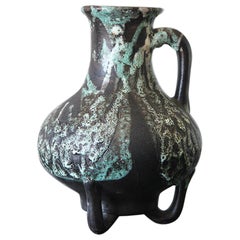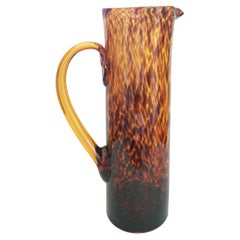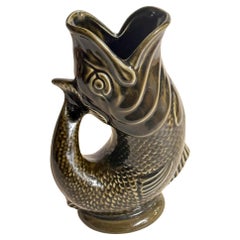West German Pottery Pitchers
to
1
1
1
1
1
1
1
1
1
1
1
36
26
23
21
20
Creator: West German Pottery
Signed German Fat Lava Glass pitcher Mint green and dark grey
By West German Pottery
Located in Los Angeles, CA
Vintage Mid Century 1960s West German fat lava pottery pitcher. Mint green bubbly glaze on smooth dark grey. Signed see picture.
Category
Mid-20th Century German Mid-Century Modern West German Pottery Pitchers
Materials
Ceramic
Related Items
Christian Dior - Empoli - Tortoiseshell Glass Pitcher, Signed, France, C.1970
By Christian Dior
Located in Chatham, ON
CHRISTIAN DIOR - EMPOLI (Manufactured in Italy (Tuscany) for Christian Dior Home) - Large and exceptional Mid Century tortoiseshell glass pitcher / vase - hand made / mouth blown with striking brown and amber patterned glass - hollow amber glass pulled handle...
Category
Late 20th Century French Mid-Century Modern West German Pottery Pitchers
Materials
Art Glass
H 11.63 in W 7.5 in D 4.38 in
Dartmouth Majolica Gurgling Fish Pitcher Green Grey color England 1950
Located in Auribeau sur Siagne, FR
Vintage Dartmouth, Devon, England green grey Majolica pottery gurgling fish pitcher. This one created circa 1950. Makes glug sound when used to pour water...
Category
1950s English Mid-Century Modern Vintage West German Pottery Pitchers
Materials
Ceramic, Pottery
Vallauris Majolica Orange Brown Ceramic Fat Lava Pitcher , 1950s
By Vallauris
Located in Barcelona, ES
Mid-Century Modern Orange Beige and Brown Glazed Ceramic Jug Vase by Vallauris. France, 1950s-1960s.
Beautiful pitcher vase or vessel with scalloped design. The exterior part is cove...
Category
20th Century French Mid-Century Modern West German Pottery Pitchers
Materials
Ceramic, Majolica, Pottery
Glass and Pewter Pitcher Set
Located in Asheville, NC
Made in Italy this Mid-Century set, one duck shaped with handle and one upright.
Category
Mid-20th Century Italian West German Pottery Pitchers
Signed Copper and Brass Pitcher with Handle
Located in Los Angeles, CA
A wonderful pitcher of hammered brass with a copper lip and fittings. The piece is a compliment to any shelf, work station or garden area. Water your plants or serve delicacies, from...
Category
Early 20th Century American Classical West German Pottery Pitchers
Materials
Brass, Copper
Vintage Steuler 'Stamp' Pitcher Fat Lava Hand Decorated Glaze, W-Germany, 1960s
By West German Pottery, Steuler
Located in Verviers, BE
A classic 60s Steuler (Stamp) design. Of fat lava handled vase, pitcher in the classic sixties decor; with a rough glaze of dark earth-colour over the Cobalt
W-Germany.
Hand deco...
Category
1960s German Mid-Century Modern Vintage West German Pottery Pitchers
Materials
Ceramic
Green Glass Pitcher and Eight Glasses by Vetri Taddei di Empoli, Italy, 1940s
By Vetrerie di Empoli
Located in Milan, IT
Green Glass Pitcher and Eight Glasses by Vetri Taddei di Empoli, Italy, 1940s
Category
1940s Italian Mid-Century Modern Vintage West German Pottery Pitchers
Materials
Glass
1960s Green Glass Pitcher American Collectible Barware
By Blendo Glass 1
Located in North Hollywood, CA
Vintage pastel green glass ware pitcher, American collectible.
1960s Green Glass Pitcher American Collectible Barware.
Gorgeous 1960s Blendo green lar...
Category
Mid-20th Century American Mid-Century Modern West German Pottery Pitchers
Materials
Glass
Murano Opaline and Glass Pitcher with handle Green Color Italy
Located in Auribeau sur Siagne, FR
Italian Vase In Glass And Opaline. Made Circa 1960.
Category
1960s Italian Mid-Century Modern Vintage West German Pottery Pitchers
Materials
Art Glass
New Murano Glass Pitcher in Gold Green and Multi Colors
Located in Troy, MI
Found in Italy, this new Murano glass pitcher has an iridescent pale green gold body with multi color splatters, streaks and some scattered murrine fl...
Category
2010s Italian Mid-Century Modern West German Pottery Pitchers
Materials
Murano Glass
Blueish Glass Pitcher Signed Still Novo
By Stilnovo
Located in Marcq-en-Barœul, Hauts-de-France
This blueish pitcher is made of glass. This is an Italian firm signed Still Novo (Sticker). Circa 1970
Category
1970s French Mid-Century Modern Vintage West German Pottery Pitchers
Materials
Glass
Fat Lava German Colored And Glazed Ceramic Pitcher
Located in Prato, Tuscany
We kindly suggest you read the whole description, as with it we try to give you detailed technical and historical information to guarantee the authenticity of our objects.
Peculiar and original German ceramic jug colored with a beautiful shade of red, black, and a vivid orange; it has a simple shape but at the same time innovative and modernist; the beautiful and vivid colors are balanced and proportioned respecting a minimalist design; the glazing of the jar was obtained by first laying down one color, proceeding to fix it by firing it in a kiln, then the same procedure was performed for the other colors; on the bottom bears the traditional mark found on this type of object, indicating that the object was created in a limited series with the jug number and the model number; unfortunately, on our jug this mark is barely legible, but it exists and allows us to say that this object was produced between 1968 and 1971 in a craft workshop in the city of Dresden (then in East Germany), an important center of porcelain and ceramic production. "Fat lava" is the name given to a certain style of East German art...
Category
Late 20th Century German Mid-Century Modern West German Pottery Pitchers
Materials
Ceramic
West German Pottery pitchers for sale on 1stDibs.
West German Pottery pitchers are available for sale on 1stDibs.
Questions About West German Pottery Pitchers
- 1stDibs ExpertSeptember 23, 2024To identify West German pottery, look on the bottom or interior for markings. Many pieces will have markings with the words "West Germany.” Others may instead or also have markings with the maker's name. By researching the maker's mark, you can determine whether the manufacturer was a West German company. Well-known West German pottery manufacturers include Scheurich, ES Keramik, Ceramano and Ruscha. Some pottery also has an item or piece number on it; this can be used to learn more about your piece's age, style or line name and other characteristics. If you can't find any markings on your piece, you may wish to have a certified appraiser or knowledgeable antique dealer help you with identifying it. On 1stDibs, shop a large collection of West German pottery.
- 1stDibs ExpertApril 16, 2024The markings on West German pottery vary. Nearly all pieces will include the words "West Germany," indicating the place of origin. Some also feature a piece or style number and/or a company logo or marking. You can compare the markings on your pottery to images posted on trusted online resources to identify pieces. On 1stDibs, explore a selection of West German pottery.
- 1stDibs ExpertFebruary 21, 2024A number of brands are West German pottery. Among them are Scheurich, Bay, Carstens, Otto, Ceramano and Dumler and Breiden. Basically, any pottery company that operated in western Germany between 1949 and 1990 can be categorized as West German. On 1stDibs, explore an assortment of pottery from some of the world's top sellers.
- 1stDibs ExpertOctober 30, 2024Yes, some West German pottery is worth something. Fat Lava-style pieces are particularly popular among some collectors, and there is often a demand for pottery produced by specific West German makers, such as Scheurich, ES Keramik, Ceramano and Ruscha. Generally, the age, style, type and condition will influence how much a particular piece may be worth. To get an estimated value for a particular item, consult a certified appraiser or experienced antique dealer. On 1stDibs, shop a selection of West German pottery.
- 1stDibs ExpertApril 5, 2024What the numbers mean on West German pottery varies. In some cases, the numbers represent the date of production. More often, the numbers represent the piece number — indicating what order it was produced in — or the style of the pottery. On 1stDibs, explore a range of West German pottery.
- How can you tell German pottery?1 Answer1stDibs ExpertOctober 24, 2024To tell German pottery, look on the bottom or inside for a maker's marking. Using trusted online resources, you can then research the marking and identify both the maker and the country in which it operates or operated. Some well-known makers of German pottery include Villeroy & Boch, Meissen, Dresdner Porzellan, Königliche Porzellan Manufaktur, Rosenthal, Fuerstenberg, Nymphenburg, Wallendorfer, Scheurich and ES Keramik. Explore a large collection of German pottery on 1stDibs.
- What is German pottery called?1 Answer1stDibs ExpertAugust 20, 2024What German pottery is called depends on its style. Pieces with embossed surfaces and thick, chunky glaze produced in West Germany are nicknamed "Fat Lava." Hard-paste porcelain produced in Germany is sometimes referred to as Meissen or Dresden porcelain, depending on its manufacturer. Early 20th-century pieces that show off naturalistic motifs inspired by the Art Nouveau movement may be called Jugendstil pottery. Shop a large collection of German pottery on 1stDibs.
- 1stDibs ExpertNovember 4, 2024To identify German pottery, look over the base or interior for the maker's markings. Many pieces will bear some type of stamp, sticker or other marking, which you can research using trusted online resources to learn who made them. From there, you can read about the maker to determine if the company or artisan is German. Some well-known German makers include Hutschenreuther, Meissen, Arzberg, Fürstenberg, Nymphenburg, Gmundner Keramik, Royal Porcelain Manufacture Berlin, Kahla and Königliche Porzellan-Manufaktur. If you can't find any maker's markings, consider having a certified appraiser or experienced antique dealer help you. Find a wide variety of German pottery on 1stDibs.
- 1stDibs ExpertSeptember 16, 2024Yes, some West German vases may be worth something. Fat Lava vases, so named for their thick, chunky glaze, are particularly sought-after among collectors and may be valuable. In general, the style, age, condition, rarity and other factors influence the potential value of a West German piece. To determine how much your vase may be worth, you can review selling prices for similar pieces using trusted online resources or consult a certified appraiser or knowledgeable antique dealer. Find a collection of West German vases on 1stDibs.


